|
The Chillington Iron Company
and the Chillington Tool Company
The Chillington Iron Works, the
first iron works to be built within the old
Wolverhampton boundary, opened in 1822 on the site
of Stowheath Manor. The works were founded by John
Barker, James Foster, and George Jones. The
company’s products were well known throughout much
of the world for their quality, and the
“Chillington” brand gained a high reputation.
|
|
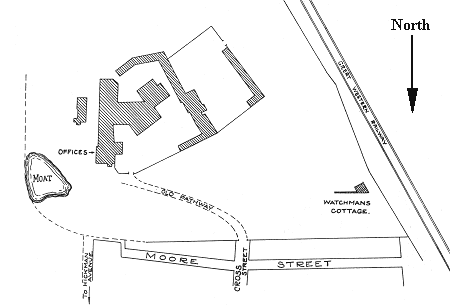
A map of the old works. |
The ironmaster at the works was
John Barker, a Justice of the Peace, a Sheriff of
the County, and School Superintendent at the Sunday
school at Snow Hill Congregational Church.
John Barker grew up on his father's farm in Cheshire
and came to Wolverhampton after obtaining the
post of assistant in Mr. Warner's drapers shop in
High Green. |
| He went into business with George Jones and they
joined forces with banker James Foster to form the
company. Mr. Foster provided most of the capital and
George Jones the business experience.
Barker was clear headed and strong
willed, and very industrious. He died in 1852 and
his two sons inherited his share in the business.
James Foster was well known for his large
manufacturing works at Stourbridge; Foster, Rastrick
and Company, and also his iron works; John Bradley
and Company, also at Stourbridge. He was born in
1786 and became a successful banker. He lived at
Stourton Castle. |
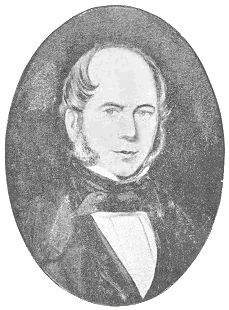
John Barker. |
|
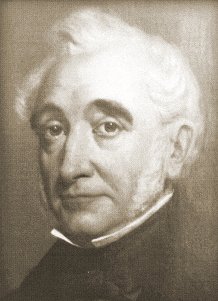
James Foster. |
The plant for the works was
designed and supplied by John Rastrick who had
joined forces with James Foster in 1816 to form
Foster, Rastrick and Company, the large
manufacturing concern at Stourbridge. They became
well known for their work on early railways and
built a few locomotives including the Agenoria, and
the Stourbridge Lion; the first steam locomotive to
run in North America.
James Foster died in 1853. He
never married and his estate passed into the hands
of his nephew William Orme Foster. |
| The site of Chillington Works, about a quarter of a
mile to the east of the canal, had its own coal and
iron ore mines, furnaces, rolling mills and
foundries. The works were connected to the canal by Chillington Basin. The old Stowheath Manor had a
moat, part of which still existed when the works
were built. It consisted of a large pool, 100ft.
long and 75ft. wide. Waste water from the steam
plant was fed into the pool. The company greatly
benefitted from the coming of the railways. On 9th
March, 1836, an order was received from the Grand
Junction Railway for 500 tons of rails and chairs.
In 1839 there were 4
blast furnaces in operation, each producing around
80 tons of iron per week. The total production in
1839 was 16,661 tons. The furnaces used a cold
blast.
John Barker’s sons George and
Thomas eventually purchased the interests of the
partners and extended the works. They leased 200
acres of land at Bentley, Darlaston where they
opened mines and set-up several blast furnaces. They
also purchased the Capponfield Iron Works at
Bilston, and Lea Brook Iron Works at Wednesbury. In
1872 the brothers transferred their properties to a
joint stock company and ran it as managing
directors. By 1873 the company had 95 puddling
furnaces, and 6 mills and forges, with the hammers
working at 10 blows a minute. They also had 6
blast furnaces working night and day at Wolverhampton, and 3 at Bilston.
At Chillington Colliery the company had around 100 shafts that were sunk for
the mining of coal and iron ore. They were
eventually closed due to a dispute with a
neighbouring mining company over the pumping out of
water, which resulted in the pumps being turned off,
and the flooding of the pits.
|
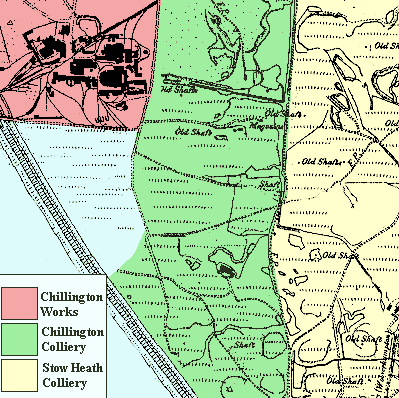
The location of Chillington Colliery which
covered a large area.
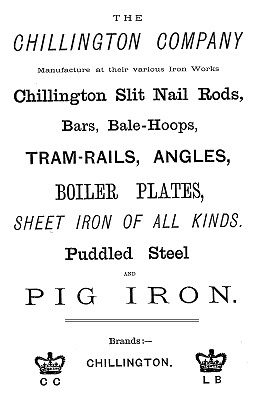 |
|
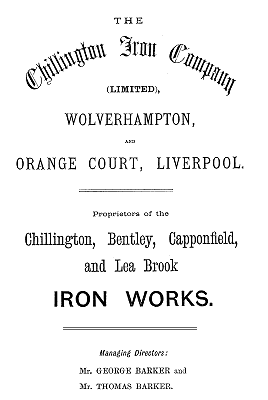 |
|
Two adverts
from 1873. |
| The company was hit hard by the
recession in the 1870s and ran for several years at
a loss. As a result serious consideration was given
to a change of direction. The minute book of the
Iron Works Board includes a reference dated 20th
April, 1876 to the “Desirability or otherwise of
taking up the edge tool trade” A further minute of
27th July, 1876 reports that “The
erection of the Edge Tool and Horse Shoe Works has
commenced”. |
In its earlier years the company produced mainly
horse shoes and became known as the largest maker of
hand-made horse shoes in the world.
The shoes were produced under the brand name “King
Of The Road”. The making of horse shoes by hand
required considerable skill and was very arduous. |
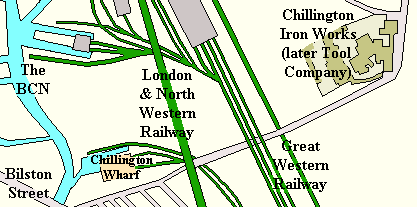
The location of the works and
the company's canal basin. |
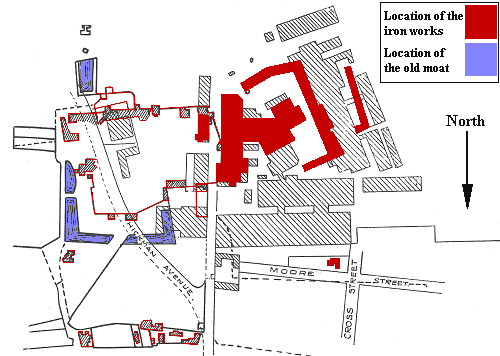
The tool works superimposed on
a map of the iron works.
|
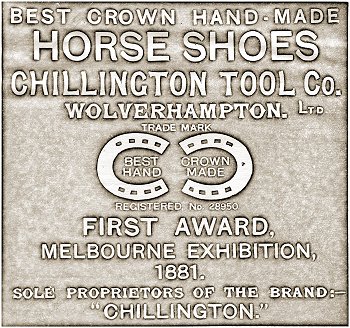
An old advert. |
It became increasingly difficult to find
sufficient smiths to meet the growing world demand,
and as the demand for hoes and other edge tools
increased, horse shoes were phased out.
The company decided to concentrate on the
manufacture of lighter edge tools such as hoes, and
would soon claim to be the largest manufacturer of
hoes in the world. The tools were sold under the
“Crocodile” brand name and included axes, forks,
shovels and spades, most of which were exported.
The Chillington Tool Company
Limited was formed in 1892 under the direction of
John William Hunt. |
| The tool works soon covered a much larger area
than the old iron works. The buildings were
greatly extended in the 1920s and included a new
up-to-date forging department. |
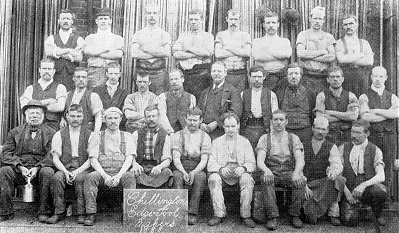
A group of workers from 1888. |
| There were forges, fitting shops, polishing
shops, an emery wheeling department, mill
department, stores, a packing department, a
laboratory, and a metallurgical department.
The works office included the wages department,
the buying department, and the drawing office. There
were also up-to-date toilets with washing basins,
hot and cold water, liquid soap, nailbrushes, and a
plentiful supply of clean, dry towels.
In the early 1920s the fitting shop was used for
the building of gas and oil furnaces. |
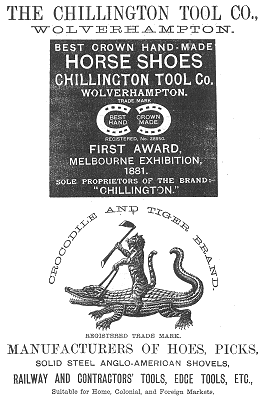 |
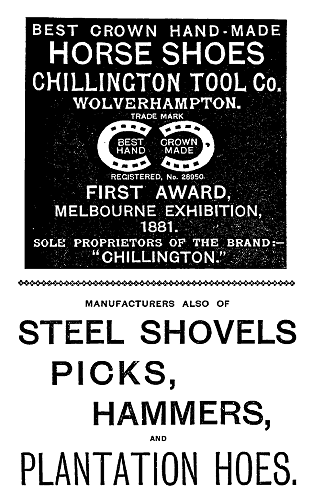 |
An advert from 1892. |
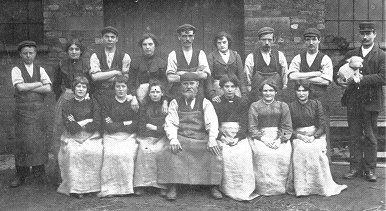 |
The Warehouse Department
in 1901. Left to right:
Back row - Tom Hitch, Sarah Booth, George Heath,
Ethel Jackson, Joe Green, Eliza Steele, Sidney
Monckton, Dave Lavell,
W. Porter and Rose the dog.
Front row - Sarah Pritchard, Eliza Pritchard, Lily
Chinn, Arthur Parkes, Minnie Jackson, Harriett
Rogers, and Esther Bodley. |
| The grinders
and polishers in 1903. |
|
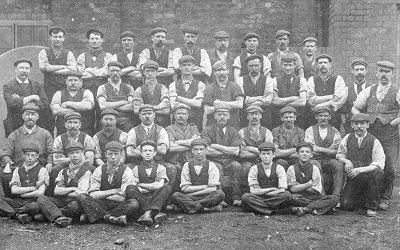 |
|
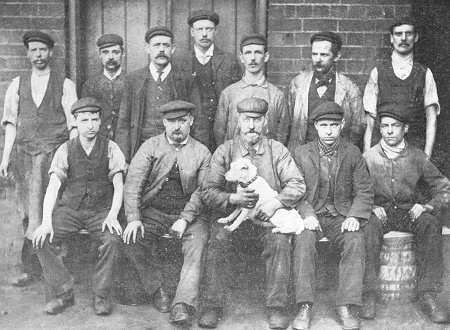
The engineering staff in 1903. |
Left to right:
Back row - J. Gandy,
A. Fisher, J. Delve,
J. Halfpenny,
W. Thomas, J. Brown, and H. Webb.
Front row - T. Gandy, G.
Fisher, J. Hopkins, W. Fisher, and
J. Vincent. |
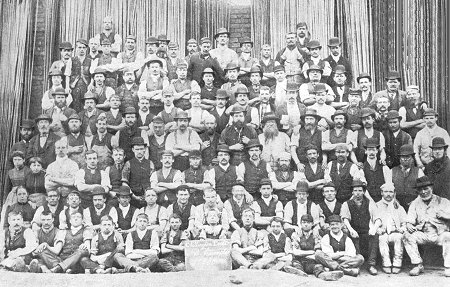
Factory workers in 1888.
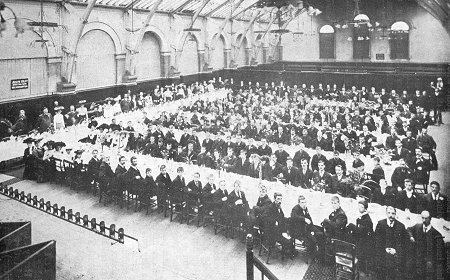
Mr. J. W. Hunt's 60th birthday
celebrations at the Agricultural Hall in 1904.
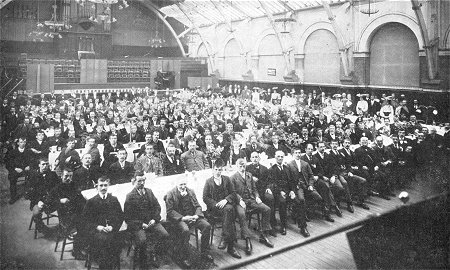
Another view of Mr. Hunt's birthday
celebrations in 1904.
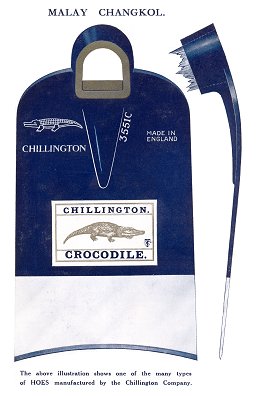 |
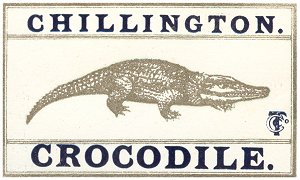
One of the many types of
hoe that were manufactured by the company. |
| An old Chillington hoe
found in the West Indies in 1930 after 12 years of
use.
The white background shows
the original size of the hoe. |
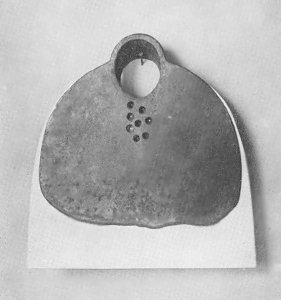 |
| In 1908 a fire broke out at the works one Sunday
morning, but unfortunately the employees were caught
without any effective means of fighting it. As a
result the company's Fire Brigade was formed. Initially the
equipment consisted of 6 lengths of hose and a wheel
valve to connect to the pump. Over the years the
equipment improved and 6 of the members, Chief
Officer H. W. Hunt, 1st Officer G. A. Fisher, 2nd
Officer S. Hopton, Engineer W. Thomas, and Firemen
J. Caddick and A. Adey obtained long service medals
from the National Fire Brigade Union. |
|
Sports and Social Activities
The company had a thriving
sports and social club known as "The Working
Men's Club and
Institute". There were many sports teams including a
thriving football team who played in the local
football league, the works league, and the J. W.
Hunt Cup, named after one of the company's founders.
There were tennis teams, athletics teams, and an
angling team who played for the Chillington
Challenge Cup, and a bowling team who played in the
Chillington Works Bowling Championship.
|
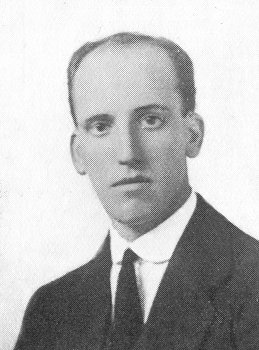
Mr. George Surplice, president
of the Club and Institute in 1929. |
Other activities were provided
by the camera club, the thrift club and the
horticultural society. Whist drives and dances were
also held at the institute, and the fancy dress
carnival dance became one of the highlights of the
social calendar. An annual outing would also be
organised. The many dances were used to raise
funds to pay for the club's activities, and for
donations to local charities. |

The 1927 Fancy Dress Ball.
In 1928 the football teams in
the Wolverhampton and District Works Sports
Association League were:
|
Division 1 |
|
Division 2 |
| Chillington 'A' Team |
|
Chillington 'B' Team |
| Sunbeam |
|
Sankeys |
| Rubery Owen |
|
Weldless Tube |
| Perks and Sons |
|
Jenks and Cattell |
| Harpers |
|
Great Western |
| Palethorpes |
|
Motor Pressings |
| Great Western |
|
Palethorpes |
| Weldless Tube |
|
Sunbeamland |
|
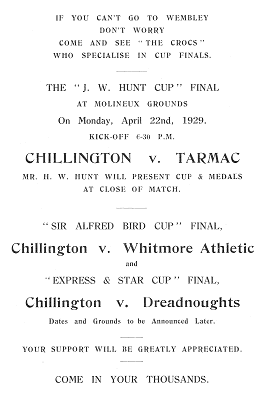 |
|
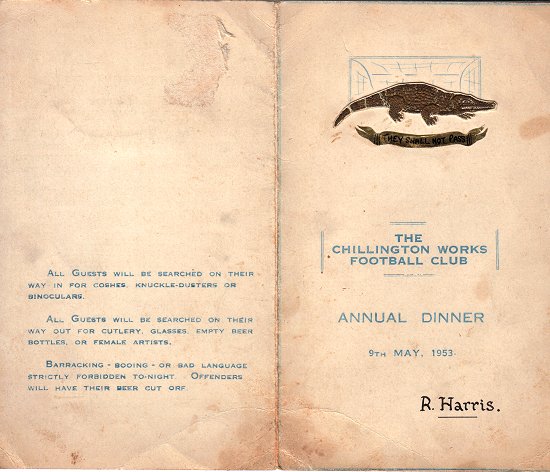
A menu from 1953.
Courtesy of Tina Harper whose father played-for and
ran the football team at the time. |
|

The inside of the 1953 menu.
Courtesy of Tina Harper. |
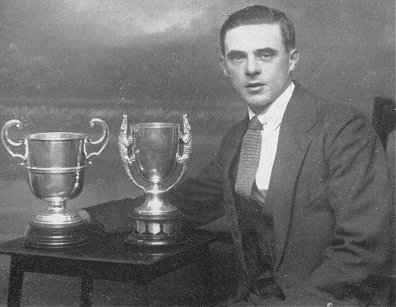 |
Louis Ward from the
Warehouse Department who played for the 'A' Bowling
Team and became the best bowler in the whole of the
Works League in 1928.
His awards included the Plant
Cup and Gold Medal for the Works League Individual
Men's Competition when he beat 175 other entrants.
He also came first in the Merit Competition, beating
J. Whitehouse of Sunbeam 21 to 11. |
| The prize winners in the
Fancy Dress Carnival held in 1928.
Left to right:
Mr. C. Walker, Mrs. C.
Walker, Miss D. Taylor, and
Mr. W. Crowe. |
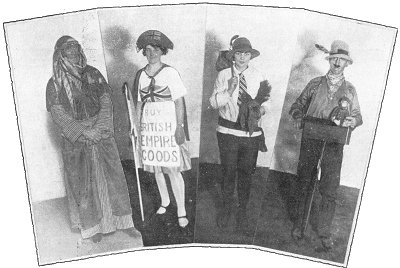 |
| The founder of the tool company, Mr. John
William Hunt died on 10th December, 1925 at his home
Maycroft, Ash Hill, Compton. He was 81 years of age.
Some of the employees
in the 1920s |
 |
Mr. Sidney Monckton
entered the company in 1889 as a warehouseman. In
1911 he took charge of the Shoe Turning Department
where he remained until 1918. afterwards he was in
charge of the General Stores.
During the First World War he
became chairman of the Chillington War Savings
Association and afterwards became secretary of the
Angling Club. |
| Mr. Aaron Heath began at
the works in 1887 as a horse shoe striker for Harry
Johnson, and later for Jack Baxter, then Joe Miller.
After a couple of years making shoes, a reduction in
demand meant that he had to return to striking. He
struck for Pat Powell, Jimmie Kerrigan and later
Arthur Wilden. After a few years he returned to shoe
making until 1917 when he began tool setting in the
Forge. He was proud
to have never drawn a day's sick pay. His two
brothers, four stepsons and his daughter all worked
for the company. |
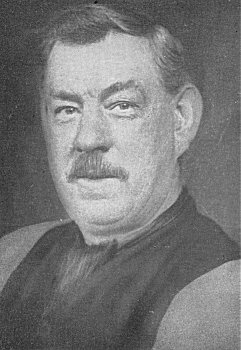 |
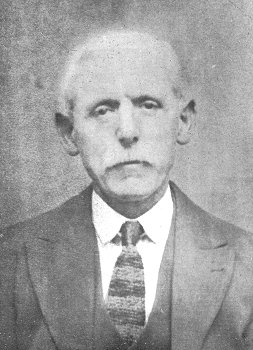 |
Mr. Jack Hewins started at
Chillington in 1885 as a boy of 14. He began his
working life heating hand-made ploughs for Dave
Smith. He then moved to the Polishing Shop to become
a polisher under Jesse Broome.
During the First World War he
became a charge hand working night shifts at a time
when much of the production consisted of entrenching
tools. After the war he continued as a charge hand
but worked on the day shift.
His two sons, two
daughters, brother and nephew also worked at
Chillington. |
| Mr. Tom Edge started work
in 1890 at the age of 13 as a heater for H.
Cartwright, a mould steeler. After some time
striking on horse shoes, and another stretch in the
Steeling Department he became a mould steeler. After
many years he became a stamper.
His 3 sons, stepson, and
daughter-in-law also worked at Chillington. |
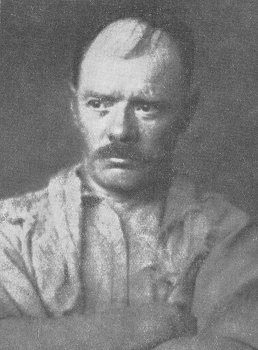 |
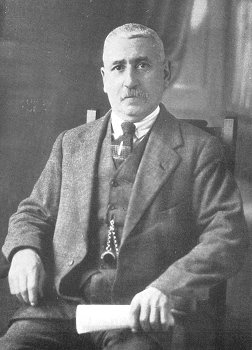 |
Mr. Harry Wilden started at Chillington in
1883 at the age of 14. He began his career
working as a heater for Harry Cartwright and was
promoted to striking before he was 16. He later
heated for Alf Heath and then joined his brother
in the Shovel Shop, where he worked for many
years. His son Harry Wilden junior and his
daughter also worked at Chillington. |
| Mr. Tom Hunt was the Works Engineer. He became
well known as a song writer and had many
compositions to his credit.
One of his songs "The Baby Tank", written in
France during the First World War, became well known
in several countries. It became quite popular and
resulted in the sale of about half a million
records. |
 |
 |
Mr. Fred Roberts started
at the works in 1889 at the age of 14 as a heater.
He later worked with his brother Tom, then started
striking for Dave Smith on odd work.
His daughter Tilly worked in
the Warehouse and his son worked in the Mill. |
| Mr. John Dutton worked for
many years as a wet grinder. Unfortunately the dust
and fine particles caught up with him and he had to
retire early on a pension at the age of 46. He was
one of the last wet grinders because that type of
grinding was abolished. After a long and trying
illness he died at the age of 50. |
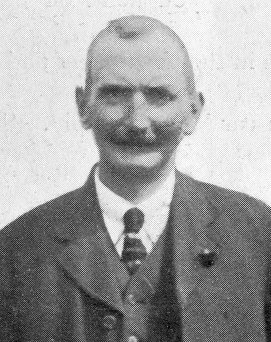 |
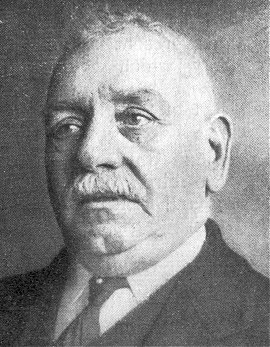 |
Mr. David Potts worked at
Chillington for 32 years as a plater. His son Albert
also joined the company as a plater, and his other
son Dave worked in the Mill. |
| Ted Bradley started work for the company in 1989
at the age of 13. He began working as a heater and
striker for Dave Smith who worked on the Coffee
Diggers and Shovel Bits. At the start he was so
short that he had to stand on a box to strike at the
hot metal. After striking for the shoe turners,
Ted migrated to the Mould Steeling Department and
remained there until the late 1920s when he was
given employment of a lighter nature.
His brother Alf Bradley also worked for a while
at Chillington as a mould steeler. |
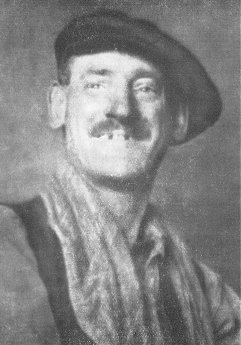 |
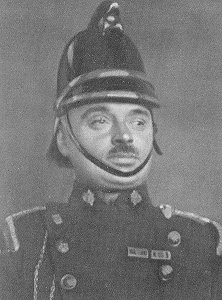 |
Mr. George Fisher started
at Chillington on 26th March, 1892 as a boy in the
Fitting Shop. He soon became a die sinker, but
unfortunately he lost the sight in his left eye
after it was struck by a chipping from a die. He
left the bench but returned during the First World
War. In 1927 he took charge of the Fire Station and
the upkeep of the fire appliances.
Strangely enough his son
Arthur also joined the staff at the Fire Station
after loosing the sight in his left eye. |
| Fred Gandy began in the
Warehouse Department under Arthur Parkes in June
1887. After 5 years he moved to the Horse Shoe
Department to strike for his brother Jack even
though this meant a drop in wages of 6 shillings a
week. After learning
his new trade he went on to punch the holes in the
horse shoes using the company's first punching
machine. It was driven by a steam engine and the
cogs jumped up and down to such an extent that it
could be heard all down Willenhall Road.
After 25 years he gave up
punching to go into cheeking up. His brother Jack
died in 1925 after 42 years service at Chillington.
His two other brothers also worked for the company. |
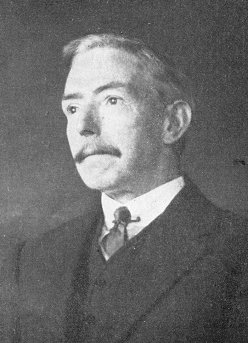 |
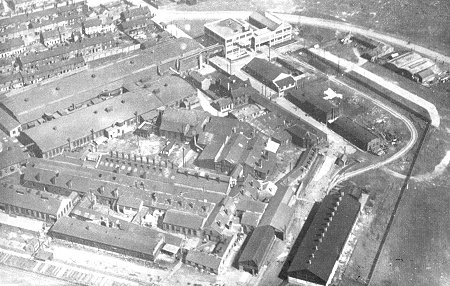
Chillington Tool Works from the air in
1928.
|
In the late 1920s the employees of the Mill and
Warehouse started a benevolent fund to provide financial help to
members who were away from work through no fault of their own,
for a period of 3 or 6 weeks. It also assisted in cases of
hardship.
Men and women over 18 years of age
contributed 3 pence and 2 pence each week
respectively, and younger members of staff
contributed one penny a week. When a man had been
away from work for 3 weeks he received £2 from the
fund, and a further £2 at the end of 6 weeks,
providing he was still off work and that sick notes
were produced. Women and juniors received two
thirds, and one third of the benefit respectively.
|
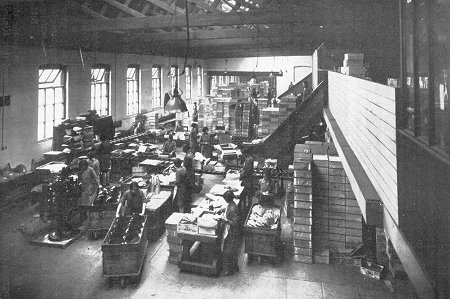
The Packing Warehouse in 1929.
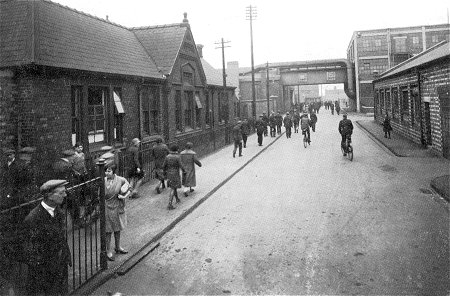
The main works drive in 1929.

Another view of the Packing Warehouse.
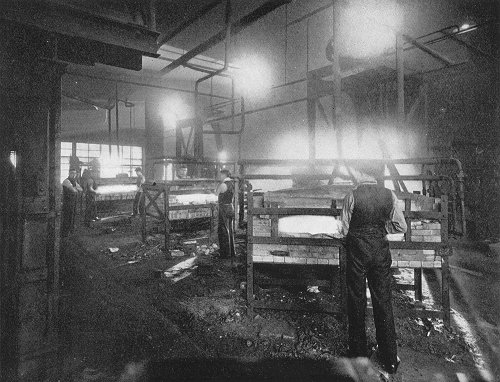
Some of the gas forging furnaces.
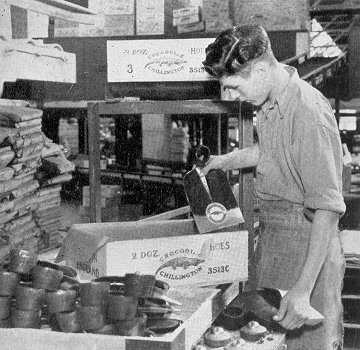 |
Packing
hoes.
|
| A bank of
electrically-powered grinding machines.
Note the overhead line shafting.
|
|
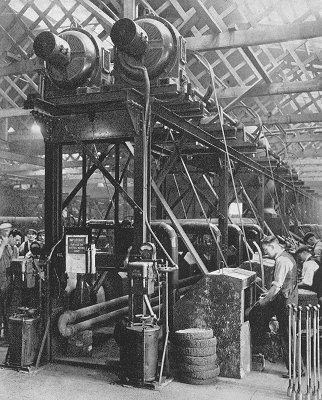 |
|
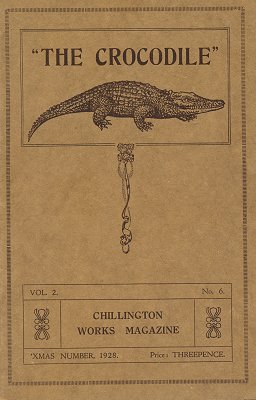
The company's works magazine. |

Building work in the late
1920s.
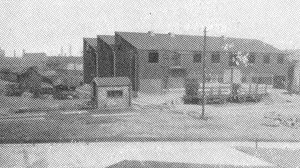 |
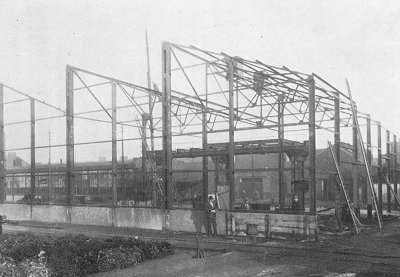
Another view of the new buildings erected
in the late 1920s.
|
In 1953 the company produced plantation hoes, bars
and forks; shovels, spades, axes and other edge
tools. Chillington and its associated companies
became the largest group of edge tool makers in the
world, exporting most of their products. The
associated companies, the EVA Industries Group of
Companies, were Edward Elwell Limited of
Wednesbury, A.W. Wills & Son Limited of
Wolverhampton, John Yates & Company Limited of
Wolverhampton, and the Pheonix Shovel Company
Limited of Cradley Heath.
By the 1950s a considerable jig and tool division,
equipped with modern high precision machine tools
had been formed to produce jigs, fixtures, and press
tools for the aircraft, motor and domestic appliance
industries. Jig boring and inspection were carried
out under ideal conditions in temperature controlled
rooms. The company also provided facilities for
special purpose machining, and manufactured rolls
and ancillary tools for tube production. |
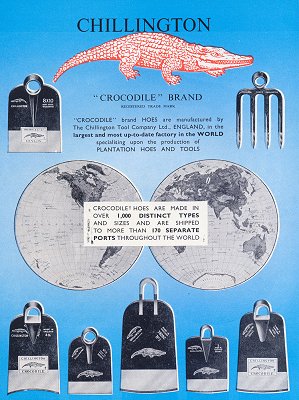
An advert from the early
1950s. |
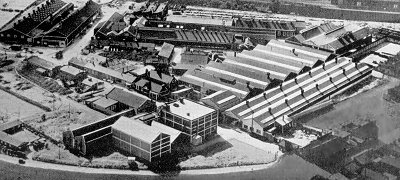
The works in the early 1950s.
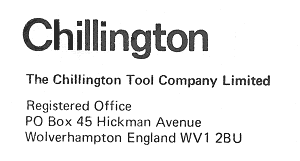
|
The Chillington Tool Company has since moved to
Willenhall and the original site is now occupied by
an industrial park. The old Chillington canal basin
was purchased by the London and North Western
Railway in 1902 to become the Chillington
Interchange Basin. Sadly it is now in a derelict
state.
|
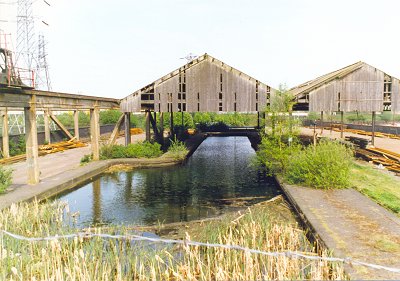
The old Chillington Interchange Basin as it
was a few years ago.
 |
Return to the
previous page |
|